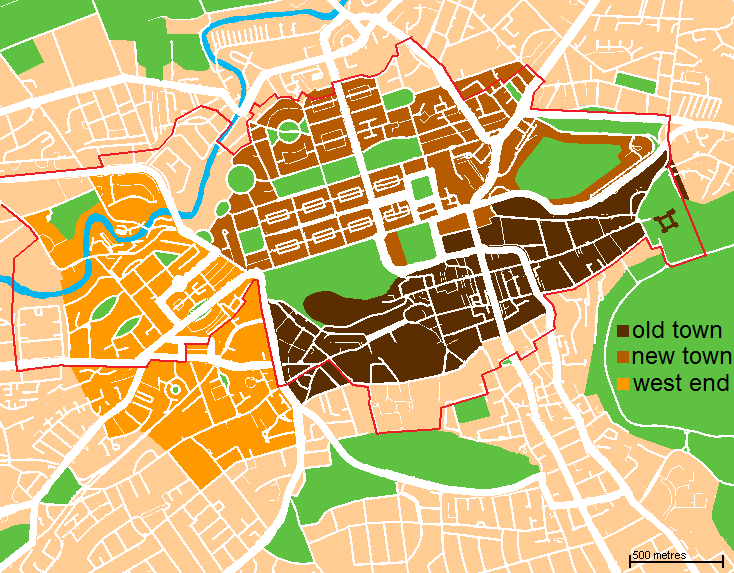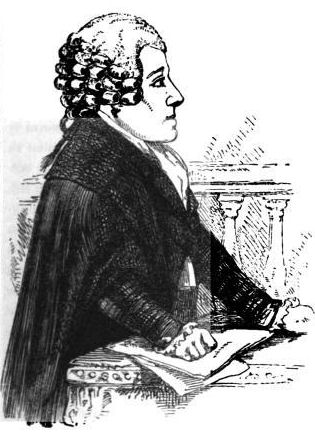|
Sir James Stirling, 1st Baronet
Sir James Stirling, 1st Baronet of Larbert and Mansfield (c. 1740 – 17 February 1805) was a Scottish banker who served three consecutive terms as Lord Provost of Edinburgh. Life He was born in Edinburgh in 1740 or early in 1741, the son of Alexander Stirling, and his wife Jane Muir, daughter of James Muir of Lochfield in Perthshire. Although sometimes stated as the son of a cloth merchant, more contemporary records state he was the son of a fish merchant standing on the Royal Mile at the head of Marlin's Wynd, now the site of the Tron Kirk. As the church predates this, the description must mean facing the Tron Kirk.Grants Old and New Edinburgh In early life he went to the West Indies as clerk to Archibald Stirling of Keir, a sugar plantation owner there (great-uncle of Sir William Stirling-Maxwell). Not long afterwards James was appointed, through Archibald's influence, as secretary to Sir John Dalling, the governor of Jamaica. Having acquired a fortune in the West Indies, ... [...More Info...] [...Related Items...] OR: [Wikipedia] [Google] [Baidu] |
Larbert
Larbert ( gd, Lèirbert/Leth-pheairt, sco, Lairbert) is a small town in the Falkirk council area of Scotland. The town lies in the Forth Valley above the River Carron which flows from the west. Larbert is from the shoreline of the Firth of Forth and northwest of Falkirk, the main town in the area. The village of Stenhousemuir lies directly east of Larbert, with both settlements being contiguous and sharing certain public amenities with one another. In medieval times, the Larbert area was heavily forested, but this was cleared and gave rise to much of the agricultural land which surrounds the town. The coming of industry and especially the arrival in the 1840s of the Scottish Central Railway, which passes through the village, provided a base for economic growth. From the late 18th century until the mid-20th century heavy industry, such as boilermaking, casting and manufacturing underpinned the economy of Larbert. The Victorian era also saw the opening of the Stir ... [...More Info...] [...Related Items...] OR: [Wikipedia] [Google] [Baidu] |
Scottish Bankers
Scottish usually refers to something of, from, or related to Scotland, including: *Scottish Gaelic, a Celtic Goidelic language of the Indo-European language family native to Scotland *Scottish English *Scottish national identity, the Scottish identity and common culture *Scottish people, a nation and ethnic group native to Scotland *Scots language, a West Germanic language spoken in lowland Scotland *Symphony No. 3 (Mendelssohn), a symphony by Felix Mendelssohn known as ''the Scottish'' See also *Scotch (other) *Scotland (other) *Scots (other) *Scottian (other) *Schottische The schottische is a partnered country dance that apparently originated in Bohemia. It was popular in Victorian era ballrooms as a part of the Bohemian folk-dance craze and left its traces in folk music of countries such as Argentina (" chotis" ... * {{disambiguation Language and nationality disambiguation pages ca:Escocès ... [...More Info...] [...Related Items...] OR: [Wikipedia] [Google] [Baidu] |
1805 Deaths
Eighteen or 18 may refer to: * 18 (number), the natural number following 17 and preceding 19 * one of the years 18 BC, AD 18, 1918, 2018 Film, television and entertainment * ''18'' (film), a 1993 Taiwanese experimental film based on the short story ''God's Dice'' * ''Eighteen'' (film), a 2005 Canadian dramatic feature film * 18 (British Board of Film Classification), a film rating in the United Kingdom, also used in Ireland by the Irish Film Classification Office * 18 (''Dragon Ball''), a character in the ''Dragon Ball'' franchise * "Eighteen", a 2006 episode of the animated television series '' 12 oz. Mouse'' Music Albums * ''18'' (Moby album), 2002 * ''18'' (Nana Kitade album), 2005 * '' 18...'', 2009 debut album by G.E.M. Songs * "18" (5 Seconds of Summer song), from their 2014 eponymous debut album * "18" (One Direction song), from their 2014 studio album ''Four'' * "18", by Anarbor from their 2013 studio album ''Burnout'' * "I'm Eighteen", by Alice Cooper common ... [...More Info...] [...Related Items...] OR: [Wikipedia] [Google] [Baidu] |
1740 Births
Year 174 ( CLXXIV) was a common year starting on Friday (link will display the full calendar) of the Julian calendar. At the time, it was known as the Year of the Consulship of Gallus and Flaccus (or, less frequently, year 927 ''Ab urbe condita''). The denomination 174 for this year has been used since the early medieval period, when the Anno Domini calendar era became the prevalent method in Europe for naming years. Events By place Roman Empire * Empress Faustina the Younger accompanies her husband, Marcus Aurelius, on various military campaigns and enjoys the love of the Roman soldiers. Aurelius gives her the title of ''Mater Castrorum'' ("Mother of the Camp"). * Marcus Aurelius officially confers the title ''Fulminata'' ("Thundering") to the Legio XII Fulminata. Asia * Reign in India of Yajnashri Satakarni, Satavahana king of the Andhra. He extends his empire from the center to the north of India. By topic Art and Science * ''Meditations'' by Marcus Aureliu ... [...More Info...] [...Related Items...] OR: [Wikipedia] [Google] [Baidu] |
Greyfriars Kirkyard
Greyfriars Kirkyard is the graveyard surrounding Greyfriars Kirk in Edinburgh, Scotland. It is located at the southern edge of the Old Town, adjacent to George Heriot's School. Burials have been taking place since the late 16th century, and a number of notable Edinburgh residents are interred at Greyfriars. The Kirkyard is operated by City of Edinburgh Council in liaison with a charitable trust, which is linked to but separate from the church. The Kirkyard and its monuments are protected as a category A listed building. History Greyfriars takes its name from the Franciscan friary on the site (the friars of which wear grey habits), which was dissolved in 1560. The churchyard was founded in August 1562 after Royal sanction was granted to replace the churchyard at St Giles' Cathedral in Edinburgh. The latter burial ground was not used after around 1600. The Kirkyard was involved in the history of the Covenanters. The Covenanting movement began with signing of the National Cov ... [...More Info...] [...Related Items...] OR: [Wikipedia] [Google] [Baidu] |
New Town, Edinburgh
The New Town is a central area of Edinburgh, the capital of Scotland. It was built in stages between 1767 and around 1850, and retains much of its original neo-classical and Georgian period architecture. Its best known street is Princes Street, facing Edinburgh Castle and the Old Town across the geological depression of the former Nor Loch. Together with the West End, the New Town was designated a UNESCO World Heritage Site alongside the Old Town in 1995. The area is also famed for the New Town Gardens, a heritage designation since March 2001. Proposal and planning The idea of a New Town was first suggested in the late 17th century when the Duke of Albany and York (later King James VII and II), when resident Royal Commissioner at Holyrood Palace, encouraged the idea of having an extended regality to the north of the city and a North Bridge. He gave the city a grant:That, when they should have occasion to enlarge their city by purchasing ground without the town, or to b ... [...More Info...] [...Related Items...] OR: [Wikipedia] [Google] [Baidu] |
Peter Williamson (Indian Peter)
Peter Williamson (1730 – 19 January 1799), also known as "Indian Peter", was a Scottish memoirist who was part-showman, part-entrepreneur and inventor. Born in a croft in Aberdeenshire, he was forcibly taken to North America at an early age, but succeeded in returning to Scotland where he eventually became a well-known character in 18th century Edinburgh. He adopted the pseudonym "Indian Peter" due to his time spent with native Americans and his self-exploitation of this in an autobiography and by touring Scotland and England in the guise of a "Red Indian". Early life Williamson was born the son of James Williamson in a croft in Hirnlay near Aboyne. He described his parents as "reputable though not rich" and at an early age was sent to live with a maiden aunt in Aberdeen.J K Gillon, Eccentric Edinburgh, Moubray House, Edinburgh 1990, p.30 Though little acknowledged in history, there was in those days a thriving trade in stolen children and others. Those engaged in kidnappi ... [...More Info...] [...Related Items...] OR: [Wikipedia] [Google] [Baidu] |
North Bridge, Edinburgh
North Bridge is a road bridge and street in Edinburgh linking the High Street with Princes Street, and the Old Town with the New Town. The current bridge was built between 1894 and 1897. A previous North Bridge, built between 1763 and 1772, stood until 1896. Current North Bridge The current North Bridge is long and has three spans of arched girders each feet in length. It is wide. It was constructed from 1894 to 1897 by Sir William Arrol & Co., the company also noted for construction of the Forth Bridge. The design of the ornamentation was by the City architect of the time, Robert Morham. The foundation stone was laid on 25 May 1896 by the Lord Provost, the Rt. Hon Andrew McDonald, with Masonic ceremonial. A medal was struck commemorating the opening of the bridge on 15 September 1897. The medal shows a view of the bridge with trains underneath and on the obverse a bust of the by then knighted Sir Andrew McDonald. Situated on the bridge is a war memorial, by sculptor ... [...More Info...] [...Related Items...] OR: [Wikipedia] [Google] [Baidu] |
Alexander Wood (surgeon)
Alexander Wood (14 June 1725 – 12 May 1807) was a Scottish surgeon, who was active in the convivial clubs which flourished in Enlightenment Edinburgh and was the founder of two of these. Owing to his lean, lanky physique he was better known to his contemporaries and to posterity as "Lang Sandy" Wood. His treatment of and friendship with the poet Robert Burns contributed to the local celebrity status which he attained. Early life and education Wood was born at Restalrig on 14 June 1725, the son of Thomas Wood (1702–1798), a farmer, and his wife Janet Lamb. He studied medicine at the University of Edinburgh and after graduating took up practice in Musselburgh. Medical practice He became a Freeman of the Incorporation of Surgeons of Edinburgh in 1756, and was appointed to the staff of the new Royal Infirmary of Edinburgh. Elected Deacon (President) of the Incorporation of Surgeons in 1762, he held office for two years. He was in surgical practice with the surgeons John R ... [...More Info...] [...Related Items...] OR: [Wikipedia] [Google] [Baidu] |
Dundas Riots
The Dundas Riots were a series of riots in Edinburgh over three consecutive days in June 1792. They are sometimes also called the King's Birthday Riots. Background The riots came on the back of a period of civil unrest, variously sourced from feelings transferring from the French Revolution, further changes in the Corn Laws, food shortages, and a general unhappiness of the population with their leading figures in politics and law. A proclamation banning "seditious writing" had been passed in May 1792. It was traditional at that time for officials and soldiers to celebrate the birthday of King George III: 4 June. On the days preceding the riots, the Lord Provost of Edinburgh, Sir James Stirling of Larbert, had cavalry soldiers roaming the Edinburgh streets to intimidate the population. This had the reverse effect, and angered the general population. The Riots On the evening of 4 June members of the City Guard and Cavalry were getting drunk at Old Parliament Hall near St Gil ... [...More Info...] [...Related Items...] OR: [Wikipedia] [Google] [Baidu] |





_Wood_with_umbrella_caricatured_by_John_Kay.jpg)
